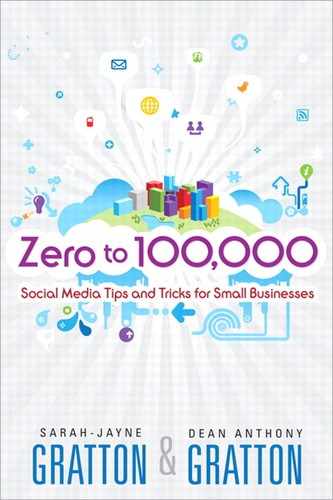14. Step 5: Instilling a Sense of Community
You’ve now laid your foundations, and it’s time to start building your unique online community. Consider your blog posts, which, with the help of Chapter 8, “Blogging Your Way to Business Success,” and Chapter 9, “The Secrets to a Successful Blog,” you should have now sketched out and entered into your social media editorial calendar for review. They should all foster a community of like-minded readers who are looking for online kindred spirits and leaders who can impart knowledge in a way that will assist them and add value to their lives. If you read through your editorial calendar and discover that your proposed posts fall short of this in some way, it’s time to go back to the drawing board in terms of content or, at least, to revise what you have laid down.
When you’re happy with your planned posts, the key to start instilling a community-focused ethos is to spend time building relationships that not only engage with site users but also get them to interact with each other. After all, visitors need to know that they are part of an online community who’s listening and who will respond and engage with them. Visitors are not likely to participate if they perceive that their comments and contributions are falling into some huge black online hole from which they will never be seen or referred to again.

Another problem can arise if none of your visitors are willing to be the first to comment and everyone waits for other comments to come in before adding their own. It’s like being the first person to ask a question at a conference. Many prefer to wait until someone else opens up the floor for them. A good way to overcome this is to start the ball rolling with comments from colleagues and friends. Then, after the comments do come in, be sure to respond to them promptly and, where possible, refer or cross-reference their remarks to other comments received, which invites engagement between the two (or more) commenters. If someone leaves a great comment, be sure to mention it, or you could even create a new blog post around it.
Remember that it takes time to build trust within a community, and the trust you do forge can be easily lost. With this in mind, ensure that your team maintains a constant dialogue with your community. The effort spent in keeping members updated can prove valuable in other ways beyond building trust in your brand. The social media platforms you build are ideal for informing your community about website changes or new products or services.
Ensure that your team maintains a constant dialogue with your community.
Content Curation
Using initial posts from those you know is an easy and effective way of getting your blog engine started, but once you start attracting comments and information from other sources, you need to think about curating this in a way that ensures a maximum return on your online community investment. Weeding out the strong content from the chaff rewards your contributors with continued value, and by involving your key influencers through the resonance and echoing of their comments, your posts will sustain their interest and intensity. Effective content curation will bring in new members to the community who will see it as a great place to comment and be heard. Content can come from a number of sources, and it’s up to you to identify the best ones in terms of industry and community relevance. After you have refined your content, you can organize and share it with your community in a way that generates comments and contributions.
Your team should work to reward contributing visitors and members early on, either through a quick response or a lengthier note of gratitude for all to see. Where possible, set up your comment system to use screen names and avatars as part of a response so that those searching can quickly identify themselves within your posts. If someone leaves a particularly thoughtful or useful comment, be sure to keep his or her username on file in a private list with a brief note about their comment. If a related thread comes around at a later date, you can then refer back to your list and ask for that individual’s specific comments. It’s a great way to reward and build a community that looks to continually support and engage with you.
Your Online Focus Group
Also consider putting your community to work as a focus group to recommend positive enhancements to your business and brand. Don’t make the mistake of thinking that your social media community need be confined to your blog. The Indian airline, Jet Airways, has built a Facebook community (facebook.com/jetairways) that provides guests with real-time news, updates about flight schedules, new customer programs, route additions, services, and special offers. It also provides guests with an online forum to discuss their experiences (see Figure 14-1).
Figure 14-1. Jet Airways became one of the first Asian carriers to form a successful online community via Facebook.
(Source: Facebook.com/jetairways)

In addition to Facebook, Jet Airways created an online community on Twitter (twitter.com/jetairways) to actively engage with its customers and major stakeholders and to provide another channel to monitor and enhance the Jet Airways travel experience.
Discovering the Nerve Center of Your Community
There are a lot of platforms available that you can choose to use to build a strong community. However, there are only so many hours in the day, and even though we show you how to use Cross Platform Promotion (CPP) later in this book to time-manage your team’s social media efforts, remember that every good community needs one nerve center—a hub of operations, if you like—from which everything else extends out and becomes connected.
Most experts agree that your social media community should begin with your blog, the reason being primarily that this is where most search engines will lead to, and it’s a place where you are unrestricted by word count and themes as with Twitter or Facebook. Many choose to use their blogs as a base station or hub, from which their brand messages are echoed out across the other platforms and followers are funneled back to the primary hub. However, this is a not a hard-and-fast rule, and if you find that the majority of your interaction takes place on Twitter or Facebook, it might make sense to focus on one or the other as the nerve center of your community.
Let It Develop Its Own Personality
Social media can help your business or brand make connections to people and groups you might never encounter otherwise. Similarly, it can help you access other people’s views and worlds in the same way that they can access yours. Over time, all of this connecting and embracing differences and viewpoints will create a unique community that forms its own personality.

It can be hard for some business leaders who are used to being in control and setting the tone of an organization to see a community they helped to establish as an independent body with its own personality and unique voice. But for a community to be all that it can be, those at its heart must be willing to embrace and support its individuality.
It’s not about letting go of ethics and morals, but about allowing a community to evolve freely. Remember that a social community is formed from the public rather than peers or employees. With this in mind, be prepared to be flexible in terms of content in a way that shows you care about your members’ views and are happy to celebrate them. Embrace user-generated content topics and give your members a sense of empowerment. Doing so will keep them loyal and ensure that the community remains fresh and continues to grow in a way that, long-term, will prove valuable for your business.
The effectiveness of your community building can be measured by monitoring increases and decreases in following, keeping track of email lists, Really Simple Syndication (RSS) subscribers, and by measuring conversion rates for your site; that is, the number of casual visits to a website compared to the number of those people who buy a product or make a similar action. Also keep track of interactions, types of engagement such as comments, follow-on post links, and their outcomes in terms of new subscribers and customers. This is a good step toward understanding your online community and giving them what they want.

